617 Search Results for tell me about it
March 19, 2014
by Carole Zangari -
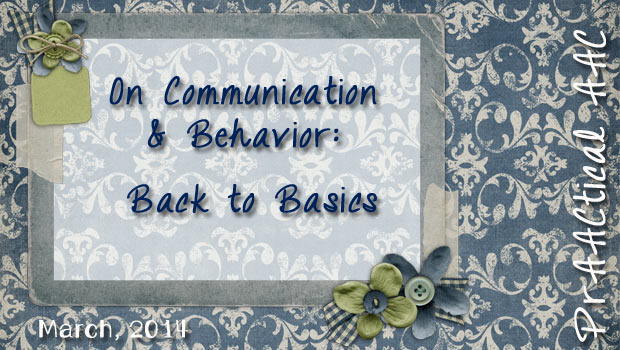
The other day we heard from an SLP who was supporting a child with significant communication difficulties. She contacted us because the team had hit a snag in their communication supports for this student. The student was successfully able to communicate with PECS but rarely did so. Instead, she used her body and challenging behavior to express herself most of the time. “Why does she hit when she can use her PECS book to tell us what she wants?” We’re not any more clairvoyant than you are, but we certainly had some ideas about this. Functional Communication Teaching can be very effective in helping people reduce their use of challenging behaviors in favor of more socially accepted means of communication. BUT, there are some of the basic principles that are have to be attended to when designing and implementing a set of behaviors that will replace the challenging behavior. This... [Read More...]
March 11, 2014
by Carole Zangari -
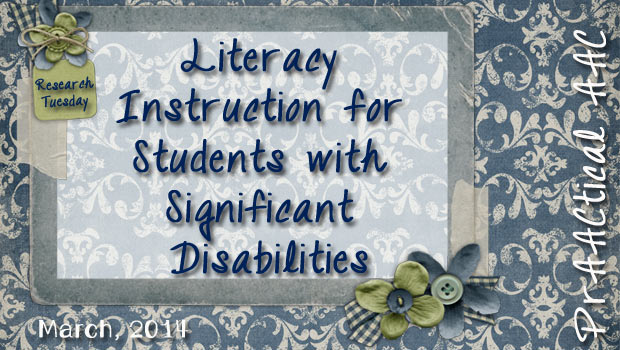
We all remember certain ‘firsts’ – your first bike, your first plane ride, your first car. One of my memorable ‘firsts’ is the first book I was ever given that was ‘just for me.’ I have fond memories of lazy summer afternoons with The Wishing Well, one of the Alice and Jerry basal readers. I may have broadened my library since that was given to me for my 4th birthday, but it still sits on my shelf and just paging through it brings back memories of being transported to another world. We can hardly imagine what life would be like without books. Reading brings us more than information. It allows us to explore, escape, relax, and dream. What must it be like to be deprived of the chance to learn and enjoy the printed word? Sadly, that is the reality for too many children and adults with AAC needs. In... [Read More...]
March 10, 2014
by Robin Parker -
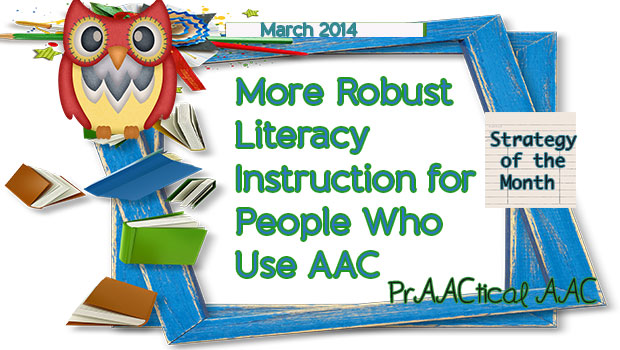
We love learning about AAC and literacy from resources that have a ‘presume competence’ philosophy, that provide research support, and that include specific teaching guidelines. With these ideas in mind, we love the Literacy Curriculum found on the Literacy Instruction Website by Janice Light and David McNaughton at Penn State. There are specific guidelines for providing literacy instruction to individuals with severe communication impairments. There is a specific curriculum to tell you what skills to teach, reasons for teaching those skills, how to teach the skills, and videotaped examples of teaching the curriculum. There is listed research support that you can use to understand the rationales for the skills you are teaching as well as provide evidence-based information about why you are choosing the approach. This post is intended to provide an introduction to the Literacy Curriculum. For comprehensive information go to the Literacy Instruction Website by Janice Light and David McNaughton.... [Read More...]
March 3, 2014
by Carole Zangari -
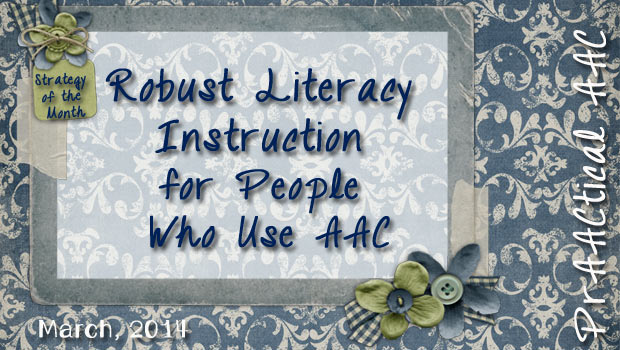
We get so many questions about the best way to ‘do’ literacy with AAC learners that decided to build on the earlier posts from and talk more about the ways in which we can support the development of reading and writing skills. For AAC learners, the most important skill set (after communication) is the ability to read and write. When given the chance, we’d teach literacy before almost anything else. Why? First, because it opens the door to so many things. When someone can read and write they are more likely to be successful with academics, find jobs and develop real careers, and enjoy productive leisure time. Secondly, we find that it changes people’s perceptions of an AAC learner. When they see Billy writing or reading with comprehension, they understand that his severely limited speech does not reflect his intellect, motivation, or potential. It shapes their perception of him to... [Read More...]
February 25, 2014
by Carole Zangari -
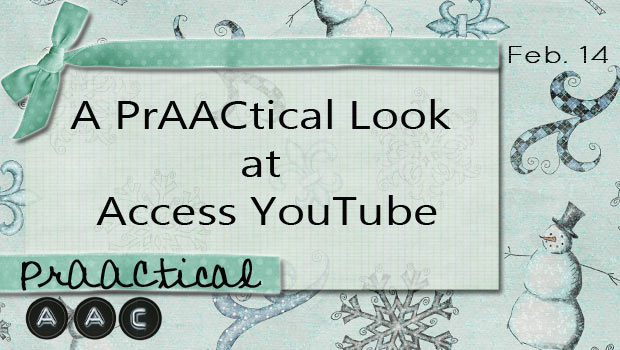
As we all know, there are many prAACtical ways to use YouTube videos to support AAC learning. When we’re looking to extend the learning outside of therapy, we sometimes use it to watch videos that demonstrate or further explain a target concept, like scarcity. Navigating YouTube can be a challenge for individuals with intellectual or physical difficulties. We can use Access Tube to make that a bit easier. The simplified layout and clear buttons make searching and playing YouTube videos easy. You can also access it with switches and touch screens. You can try it out by clicking on the image below.
February 11, 2014
by Carole Zangari -
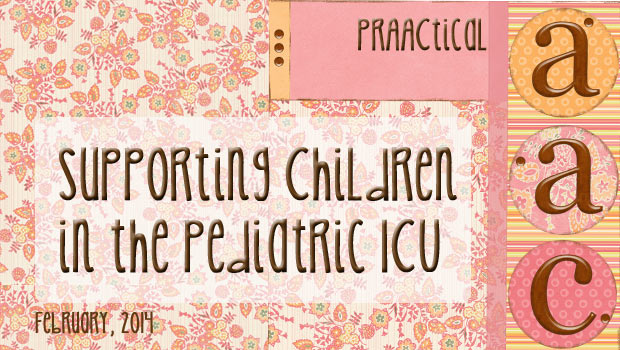
If there is anything scarier than having a very sick child in the ICU, it has to be when that child has no means of communication. In this Research Tuesday post, we join the efforts spearheaded by Rachel Wynn of Gray Matter Therapy to share an article that discusses the issues and presents some solution strategies. When we think of research studies in SLP, we think of experimental designs and randomized controlled trials (RCTs). In AAC, group research designs are uncommon because of the immense heterogeneity of this clinical population. Even limiting the study to one single disorder and age group, say teenagers with dysarthria secondary to cerebral palsy, contains too much heterogeneity for most group research. Instead, we see more single subject design experimental studies (SSEDs) in AAC. When well-designed, SSEDs have strong experimental control and allow researchers to answer causal questions, such as “did the treatment (e.g., teaching... [Read More...]
January 28, 2014
by Carole Zangari -
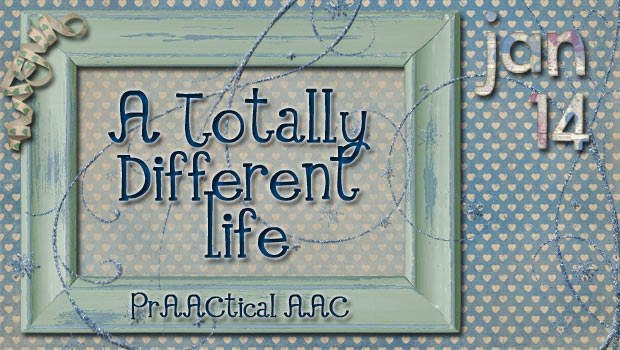
People with AAC needs have so much to say, something I was reminded of recently when I pulled an old, dog-eared book from my shelf and got lost leafing through the essays. In spite of all the challenges he faced, Thomas Bratt, a Swedish man who became speech impaired from a massive stroke at age 23, reminds us that courage and a sense of humor count for something. In the book, Conversations with Nonspeaking People, Bratt tells about taking a trip on his own to see Venice two years after his stroke at a time when he was still severely aphasic. “I didn’t know what I was going to do. I wanted to go to Venice. And at that time I couldn’t even speak Swedish. What difference would it make then if I couldn’t speak Italian?” (1984, p.26). Bratt, T. (1984). A totally different life. In Conversations with Nonspeaking People. Toronto:... [Read More...]
January 23, 2014
by Carole Zangari -
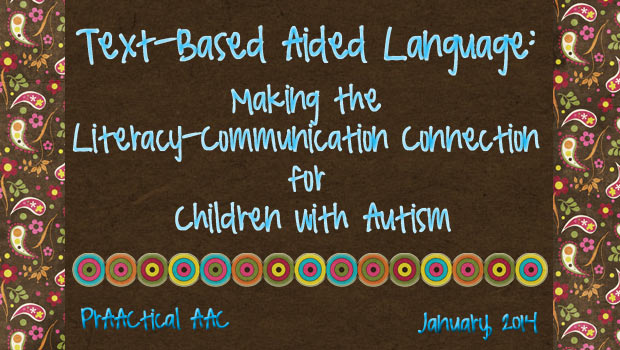
We are so pleased to have this guest post by Alicia Garcia. She is the lead SLP at AAC Clinic at One Kids Place, in Ontario. You can read her previous post here. Today, Alicia takes us in a textual direction. Enjoy! When working with children with autism who have complex communication needs we have found it is not uncommon to see children who, despite having significant communication and language challenges, can read and sometimes type words. Their ability to decode written words is far superior to their ability to communicate their wants, needs and thoughts. Some of these children use AAC systems for their face-to-face communication and, in some cases, have a literacy program in place; they frequently have handy access to writing or typing tools. These children do not, however, use text to communicate with people. They have not made the Literacy-Communication connection. We wonder… how do we help these... [Read More...]
January 22, 2014
by Carole Zangari -
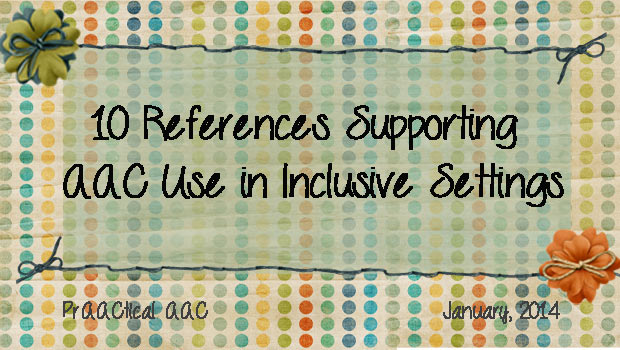
We sometimes get contacted by colleagues who are looking for references supporting the use of AAC. Here are some that are specific to inclusive settings in schools and in the community.* Alquraini, T., & Gut, D. (2012). Critical components of successful inclusion of students with severe disabilities: Literature review. International Journal of Special Education, 27(1), 42-59. Balandin, S., & Duchan, J. (2007). Communication: Access to inclusion. Journal of Intellectual and Developmental Disability, 32(4), 230-232. Batorowicz, B., Mcdougall, S., & Shepherd, T. A. (2006). AAC and community partnerships: The participation path to community inclusion. Augmentative and Alternative Communication, 22(3), 178-195. Calculator, S. (2009). Augmentative and alternative communication (AAC) and inclusive education for students with the most severe disabilities. International Journal of Inclusive Education, 13 (1) 93-113. Carter, M., & Maxwell, K., (1998). Promoting interaction with children using augmentative communication through peer-directed intervention. International Journal of Disability, Development, and Education 45(1) 75-96. Daugherty,... [Read More...]
January 13, 2014
by Robin Parker -
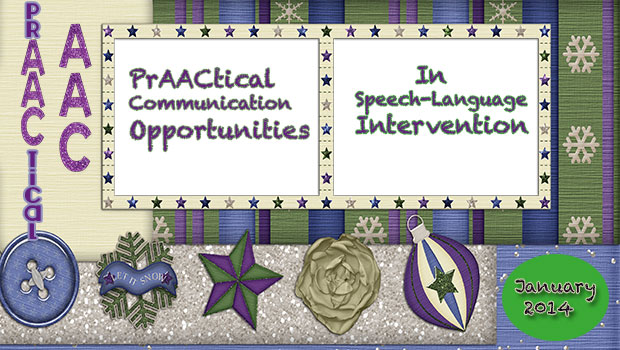
Planning for communication opportunities in every aspect of speech-language therapy helps ensure productive use of time and effort for both clinician and learner. It is not enough to talk to a student, it is not enough to provide fun activities without lots of opportunity for active participation and more specifically communication initiation. Another word for communication initiation/opportunities is communication temptations. Communication temptations are structured situations designed to entice a variety of specific communication functions or semantic relations (Wetherby, 1988). There needs to be lots of times where there is targeted modeling and then a specific, obvious reason for the learner to be the initiator of communication. A temptation to communicate. Take a look at this sample therapy session for frequent and multiple communication opportunities. Please let us know a favorite or creative communication opportunity that you use. PrAACtical Considerations Meaningful AAC Goals– All quality speech-language intervention sessions start with meaningful... [Read More...]









